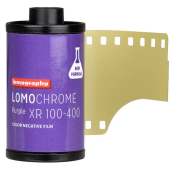wtburton
Member
I developed my first roll of lomochrome purple recently, it was the last of many rolls, so I put it in with the roll of old expired color film. (I dont normally do two at once, but I was tired)
I was kind of surprised to see when I took it out of the tank, that it had a very purple band running down the center of the regular color negative. The sides of the film look normal.
Things to note:
It was not the old color film, as I developed all other rolls of the same batch and they were normal.
I process in a modified ECN-2 recipe with ~8 times the normal amount of carbonate, increasing the PH a ton. (this increases dye formation a ton)


I dont know if anyone else has had this issue? from now on I will process lomo purple separately in a different dev batch.
I was kind of surprised to see when I took it out of the tank, that it had a very purple band running down the center of the regular color negative. The sides of the film look normal.
Things to note:
It was not the old color film, as I developed all other rolls of the same batch and they were normal.
I process in a modified ECN-2 recipe with ~8 times the normal amount of carbonate, increasing the PH a ton. (this increases dye formation a ton)
I dont know if anyone else has had this issue? from now on I will process lomo purple separately in a different dev batch.














